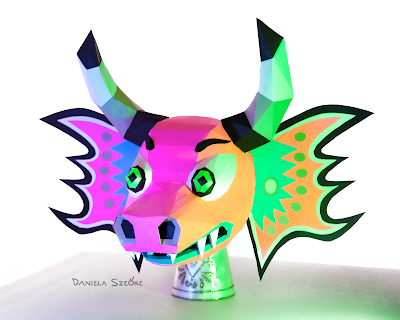Papercraft Venezuelan Devil
 |
| My digital illustration of the Diablo |
After 3 weeks of planning, intense modelling in Rhino, and cutting and scoring dozens of paper forms, this project has come to a wonderful end.
The final product is a lot different from what I initially envisioned; I had thought of making a more androgynous mask (like the illustration I created on the left). As I worked on the concept, I subconsciously began to make a more feminine mask to fit my personality. Since the traditional masks are more masculine, it was very exciting to create a feminized version that I feel identified with.

Cultural Context
The Diablos Danzantes de Yare (The Dancing Devils of Corpus Christi) are a set of popular Venezuelan religious festivals held on Corpus Christi, celebrating the presence of Christ in the Eucharist. The festivals have 300 years of history, and they are one of the most important symbols of Venezuelan tradition.
Artists make the Diablo masks out of papier-maché, and dancers wear them for ritual dances on the streets. All the performances represent the victory of good over evil, and they end with the devils’ masks falling to the ground in Jesus’s presence, indicating that they cannot defeat him. The devils kneel before Christ's image, and at this moment, the crowd gathers in prayer and asks for God's mercy.
This year, 2021, the celebrations will take place on the 3rd and 4th of July.
In homage to my Venezuelan heritage, I chose to make a geometric papercraft version of the Diablo mask with a feminine flair. To fit my design within the scope of this project, I opted for a simplified and perfectly symmetrical version of the Diablo mask. However, I did keep several of the traditional features such as the tiered-bull-horns, reptilian frills, large nostrils, tapered eyes, and overhanging fangs.
When comparing the initial 3D model of the mask with the real-life paper re-creation, they appear very similar. It was a lot of work to create the templates and to check that they matched the digital models perfectly, but it definitely paid off!
As I was constructing the paper model, I even made some minor improvements to the design such as making a more pleasing eyebrow shape. I also glued the paper in such a way to create a more rounded and organic look.
In last week's blog post, I included several process images of the mask in construction. I also discussed my experience with the in-class peer-feedback session from two weeks ago; "quite honestly, I did not receive suggestions on improvements for my templates during last week's [session]. With the amount of time during each meeting, it may have been hard for other students to look through all my forms and spot errors. Fortunately, I was able to notice issues in my work when I looked at it with fresh eyes this week. The main thing I noticed was that I had not fully optimized the space on the sheets of paper and had applied too many tabs. With these things in mind, I improved my templates accordingly."
I am very satisfied with the outcome of this project and I feel motivated to continue making more masks on my own time. I can imagine creating a series of masks with different colours, sizes, physical features, and expressions. After doing this papercraft process for the first time, I feel confident that I can be quicker and more skilled in my future attempts. There is also something very rewarding about creating works inspired by my culture because it allows me to learn more about myself and appreciate my heritage.
 |
| Detail view of the mask illuminated with coloured LED lights |
 | |
|
 | |
|












Outstanding. Truly.
ReplyDelete